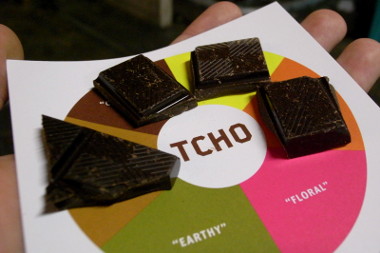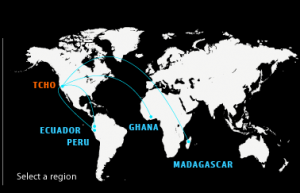
TCHO Chocolate is a “New American Chocolate” company located in the San Francisco Bay Area in California.
Their chocolate is sourced from Peru, Ecuador, Madagascar and Ghana. To learn more about TCHO’s chocolate sourcing click here.
TCHO Chocolate became about due to an obsession with flavor, quality, innovation and sustainability.
As Brad explained, there are major disconnections within chocolate companies. These include geographic, socioeconomic, cultural (language, etc.), technical resources, and the information on what buyers want. Cacao quality hasn’t been focused on until recently.
“TCHO has brought the very same innovation and technology of our factory lab to our farmer partners, enabling them to make small batches of chocolate. (Surprisingly, most growers have never tasted chocolate made from their beans.) We work closely with our coop partners to provide the sensory training that enables them to understand the true driver in the value of their product: flavor.” (Taken from the website)
By having a communal language, this can help tastes become more fluent and similar, pinpointing what the company is directly looking for. This can be hard to teach and find the same language of experience though. A way to go about finding a common language and range for chocolate flavors, a system called “Cropster” was used. This is a current and ongoing database used where the sensory information is recorded among the tasters.
Special thanks to TCHO chocolate for contributing to the study of Terroir!
Some variables that influence chocolate:
-Origins in the Colombian basin in the early 1500’s, chocolate was discovered by the Spanish. This happened before coffee and tea. Yet the biggest home was found in West Africa, where about 70% of cacao was harvested from.
Cacao trees are pollinated by midge flies. There are also very few flowers that make it into pod production. Pods are very diverse and range in shape, size and color. Depending on the ripeness and pod variety, fruit of cacao will taste different.
The beans themselves though have about 600 flavor compounds.
Social/economic side of chocolate:
-Most cacao farmers don’t ever taste the cacao, and rarely the chocolate themselves. By providing education to the farmers, this can enhance quality productivity, and capacity rates.
For example, this can be done by improving infrastructure. When providing and installing fermentation and drying systems, this can keep the beans quality. This will then lead to the farmers making more money, because of the company’s willingness to pay for higher quality beans.
Terroir and quality of chocolate:
Temperature and pH can also influence the flavor of chocolate in fermentation systems.
The color of the beans is often due to the fermentation process.
Fermentation itself is tested by wiring systems to find the desired range for quality.
A sensory analysis is also an important part of the process to do- which checks for flavors of the chocolate by a variety of people. These tastings are often done by food scientists, by farmers as well.



